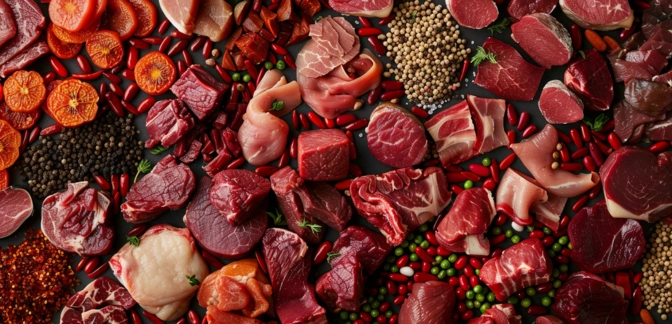Ground Meat — Nutrients, Health Benefits, and Shopping Tips

Written by Listonic Team
Last update on September 4, 2024
Nutrition facts
Nutrition facts
Amount per 100 g
Calories
🔥 263 kcal
| Nutrition per: 100 g | Value | % Daily Value* |
|---|---|---|
| Carbs | 0 g | - |
| Fiber | 0 g | - |
| Sugars | 0 g | - |
| Glycemic Index | 0 | - |
| Protein | 17 g | 34% |
| Sodium | 75 mg | 3.26% |
| Total Fat | 21 g | 26.92% |
*The % of Daily Value (DV) tells you how much a nutrient in a serving of food contributes to a daily diet. 2,000 calories a day is used for general nutrition advice.
17 g
🧀 Good Protein Content
Did you know?
Health benefits
- High in protein, essential for muscle growth, repair, and overall body function.
- Contains essential vitamins and minerals such as iron, zinc, and B vitamins, which support energy metabolism, immune function, and overall health.
- Versatile and easy to cook, making it a convenient option for a variety of meals.
- Provides healthy fats (depending on the type of meat), which supply energy and support cell function.
Health risks
- High fat content particularly in certain types of ground meat like beef or pork, which can raise cholesterol levels and increase the risk of heart disease.
- High sodium content in some pre-seasoned or processed ground meats, which can contribute to hypertension and increased cardiovascular risks.
- Risk of contamination with harmful bacteria such as Salmonella or E. coli, particularly if the meat is not properly cooked to a safe internal temperature.
- Potential for preservatives and additives in processed ground meats, which may cause adverse reactions in sensitive individuals.
How to choose ground meat
Ground meat, whether beef, pork, or turkey, should be pinkish-red for beef or pale pink for pork and poultry, and it should have a fresh smell. The texture should be fine and not overly fatty. Press the meat slightlyto ensure it’s springy, indicating freshness.
Avoid ground meat that smells sour or has a slimy texture, which are signs of spoilage. Good ground meat should cook up juicy and flavorful, retaining its texture and shape in dishes.

How to store ground meat
Ground meat should be refrigerated immediately after purchase. Store it in its original packaging or transfer to an airtight container. Properly stored, ground meat can last up to two days in the refrigerator.
Leaving ground meat out for too long can lead to bacterial growth and spoilage. It's best to avoid refreezing once thawed to maintain quality. Ensure it stays cold and properly sealed to maintain freshness and prevent contamination.
✅ Extra Tip
How long does it last?
Ground meat can last for 1-2 days in the refrigerator. For longer storage, ground meat can be frozen for up to 3-4 months. Proper packaging, such as vacuum-sealing, helps maintain its quality over longer storage periods.
What to do with leftovers?
Leftover ground meat can be used in a variety of dishes, both savory and hearty. Use it as a filling for tacos, burritos, or quesadillas, where its versatility allows for a range of seasonings. Ground meat is also great in pasta dishes, such as spaghetti Bolognese or meat sauce for lasagna.
Use ground meat in a casserole with vegetables, rice, or potatoes, or mix it into a meatloaf with breadcrumbs, eggs, and seasonings, then bake until cooked through. If you have a lot of ground meat, consider making a batch of meatballs for pasta or sandwiches, or using it as a filling for stuffed vegetables like peppers or zucchini. Ground meat can also be added to chili, soups, or stews for extra protein and flavor, or used as a topping for pizzas or nachos. For a quick snack, cook ground meat with onions and spices, then serve with tortillas or over rice.
👨⚕️️ Medical disclaimer
How ground meat supports specific health conditions
Ground meat, whether beef, pork, or poultry, is a high-protein food that supports muscle health and aids in tissue repair. It is also a good source of essential vitamins and minerals like iron and B vitamins, promoting blood health and brain function. Choosing lean ground meat options can help maintain heart health by reducing saturated fat intake. Pairing ground meat with fiber-rich vegetables can further enhance its nutritional benefits.
Discover products from other categories
Listonic Team
Fact-checked
Our editorial team checked this article to make sure it was accurate at the time of publishing it.
Get the top-rated shopping list app on your phone!







